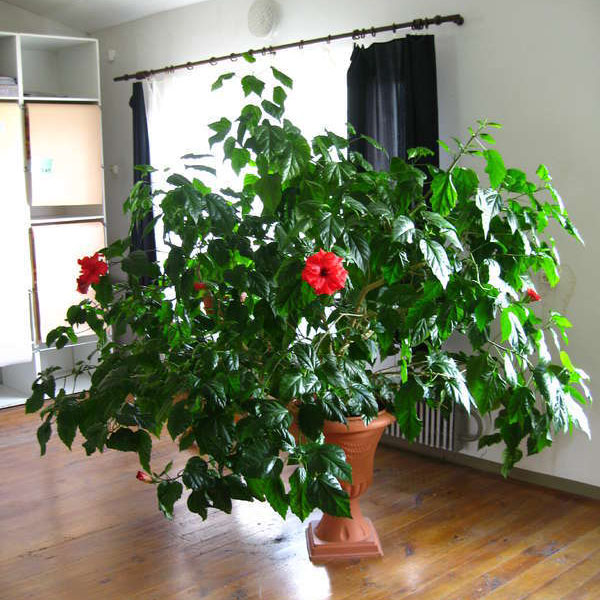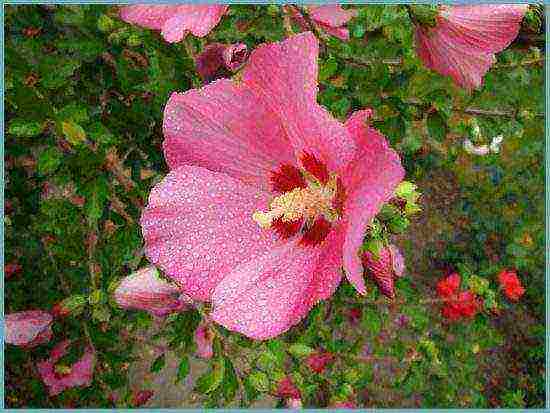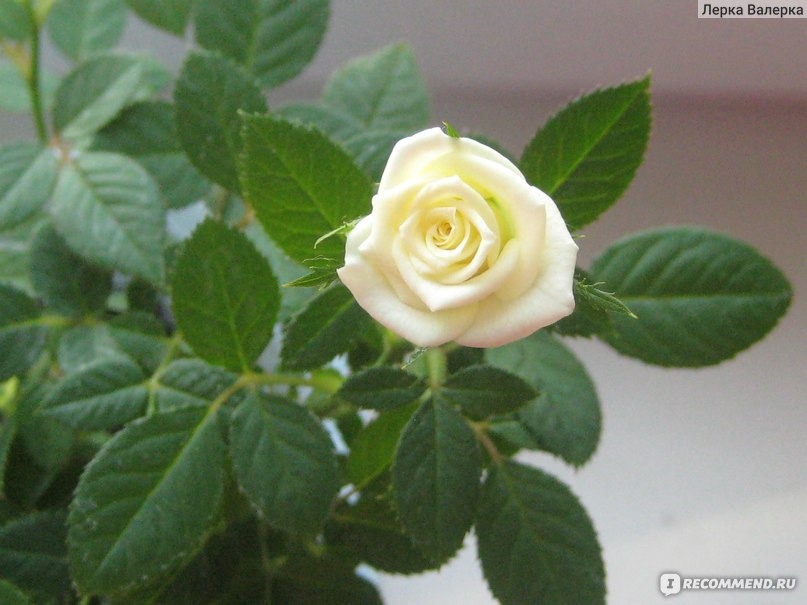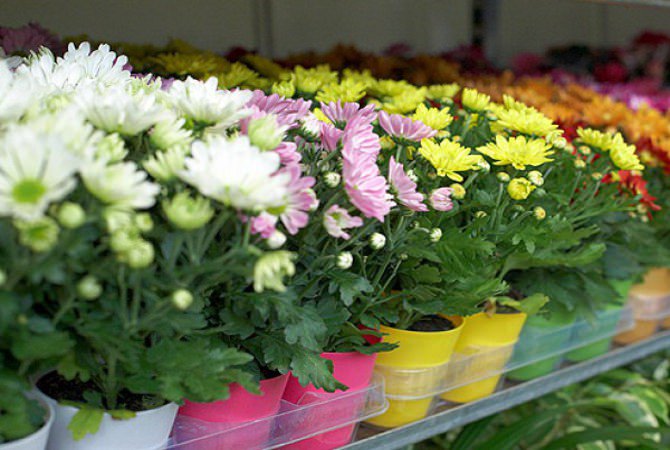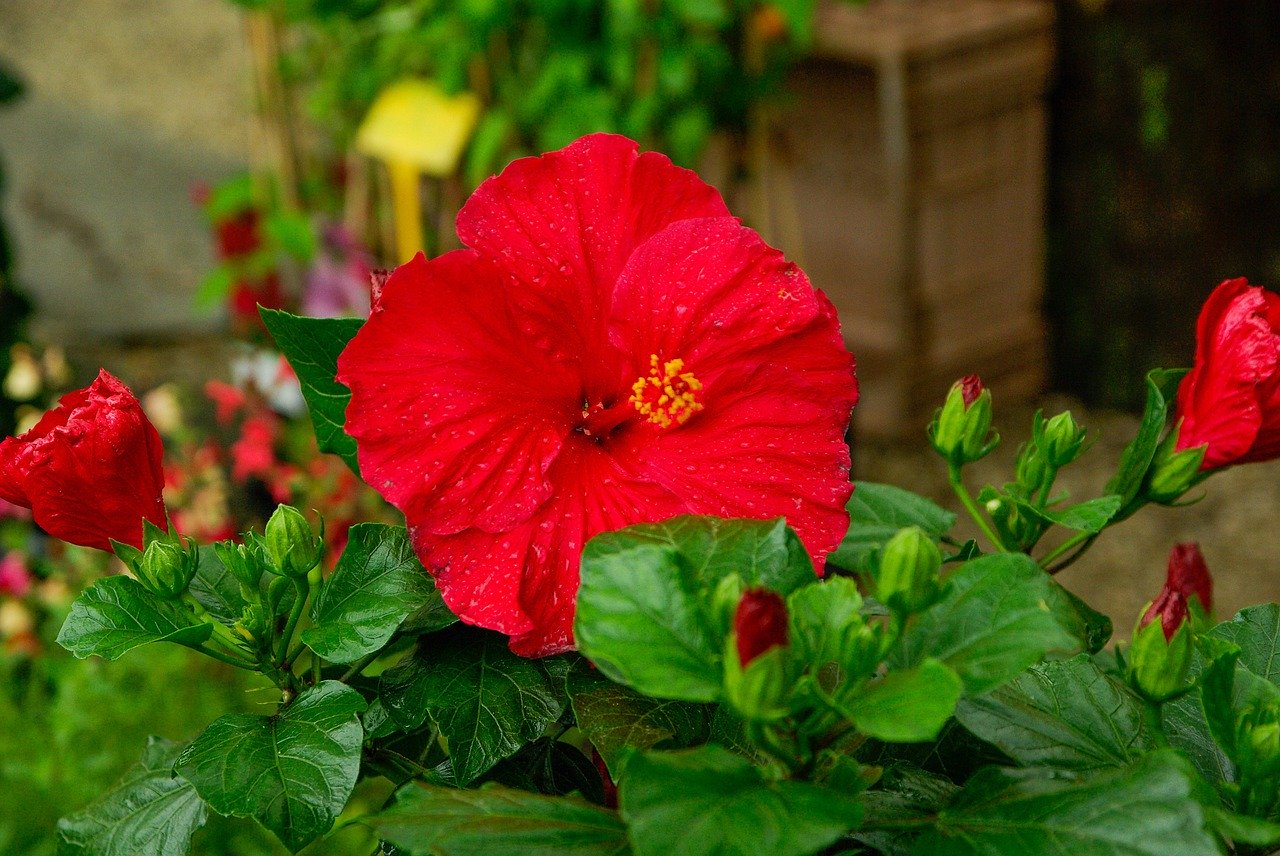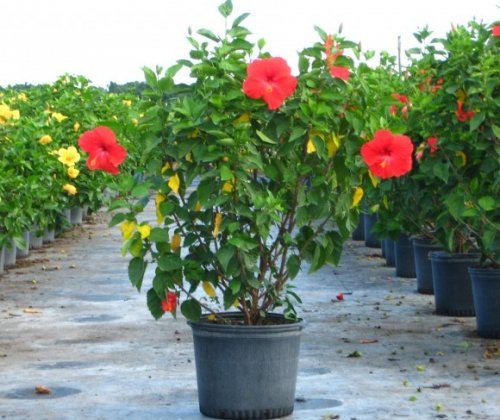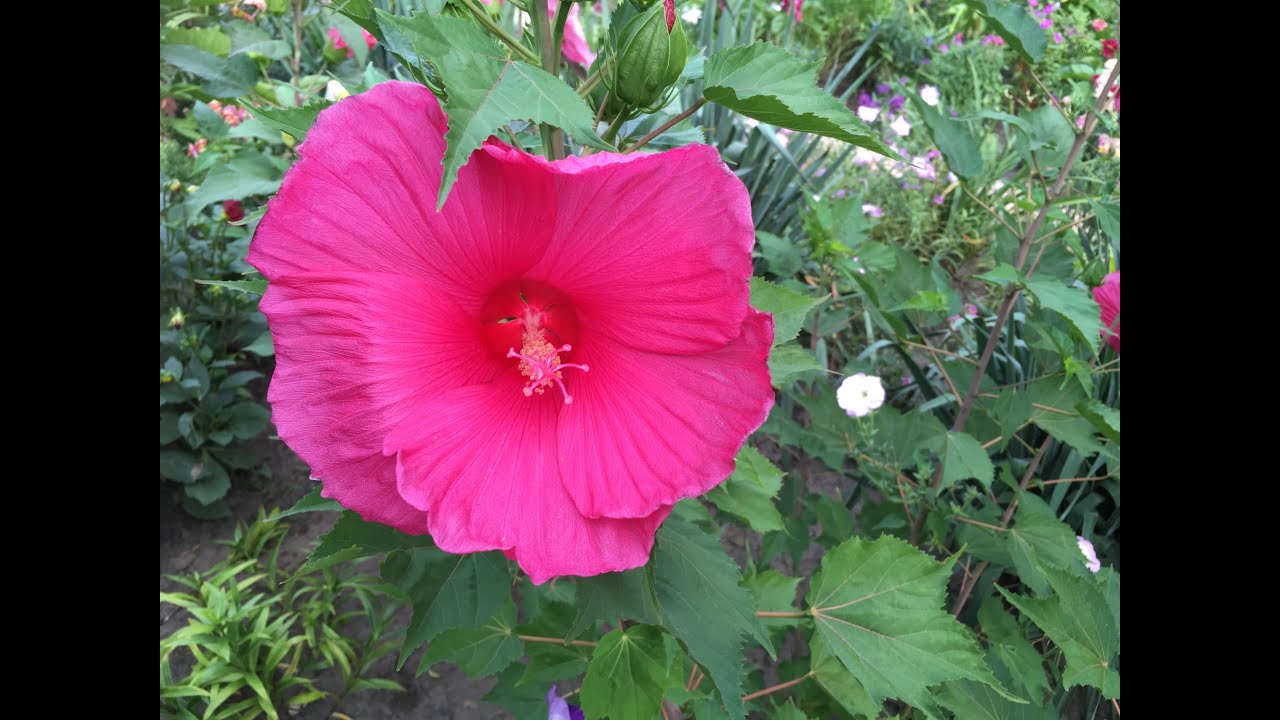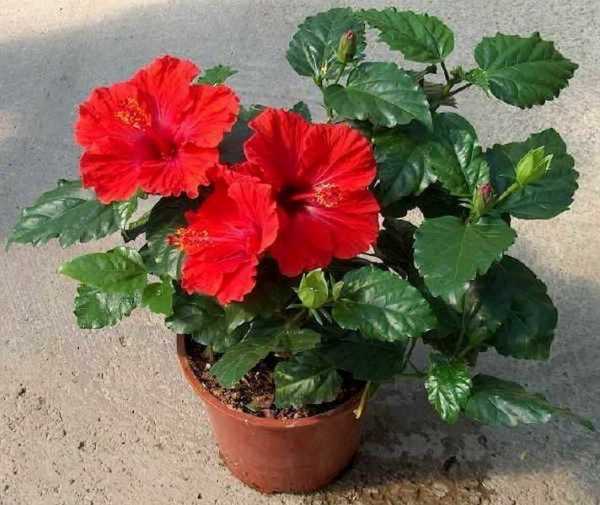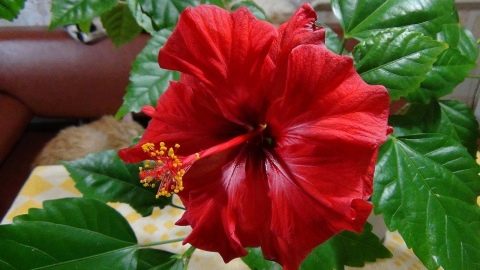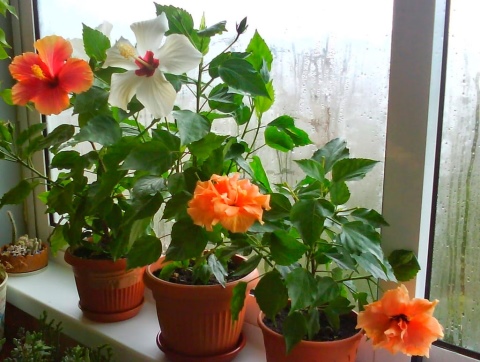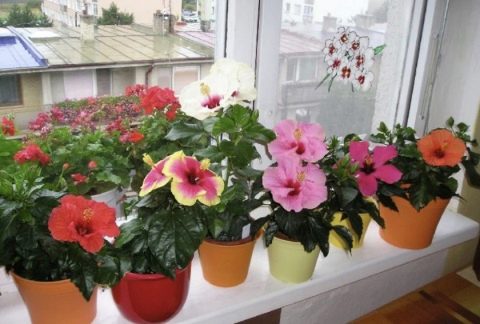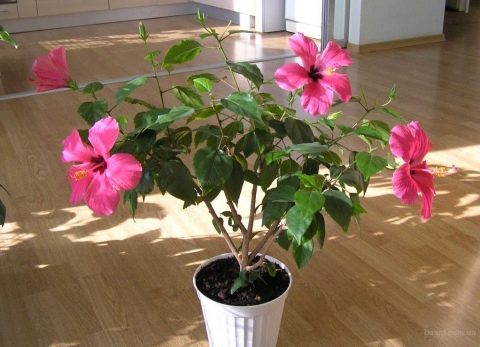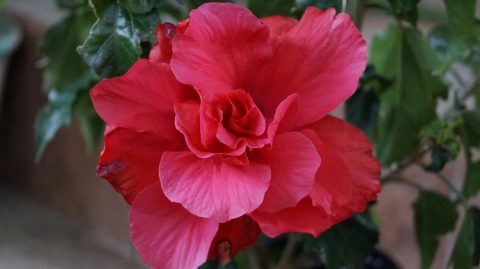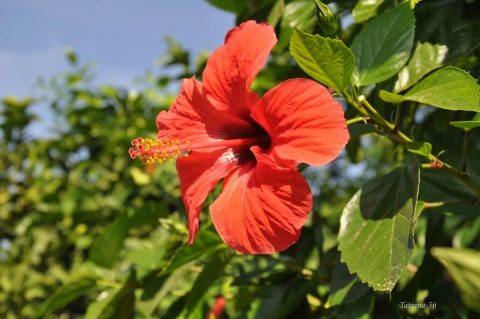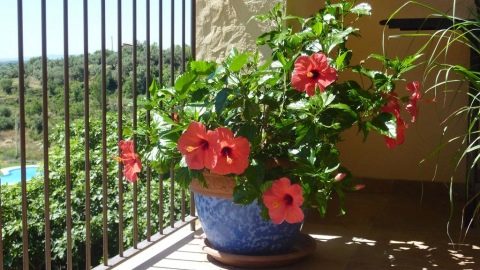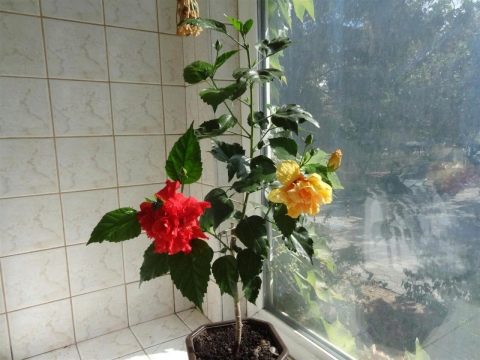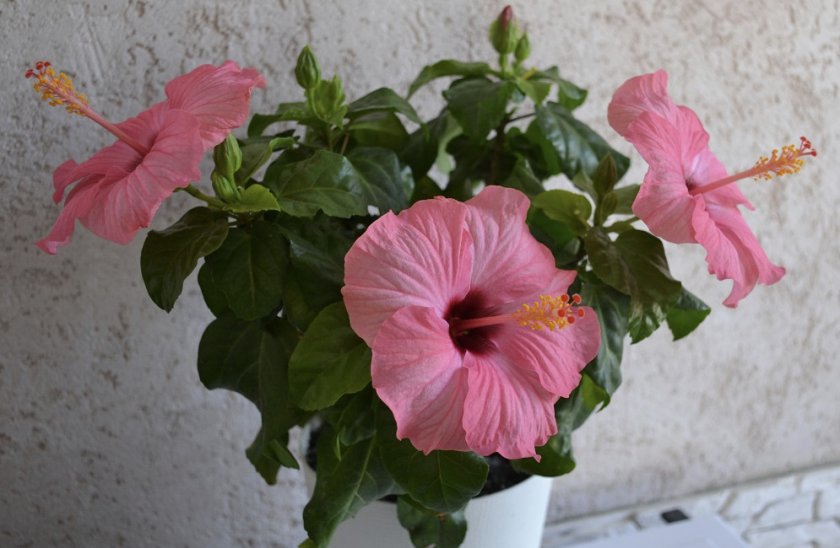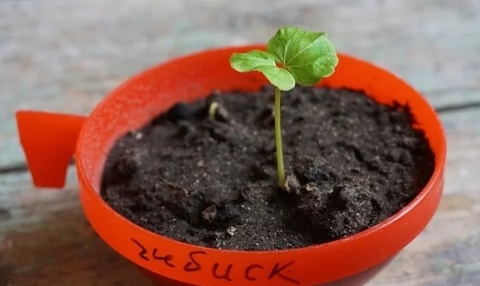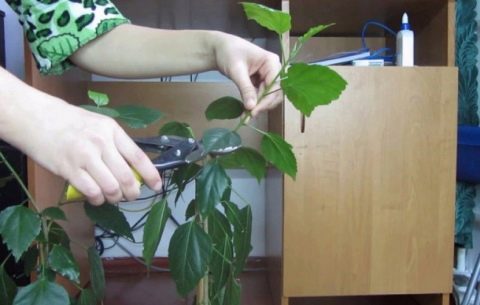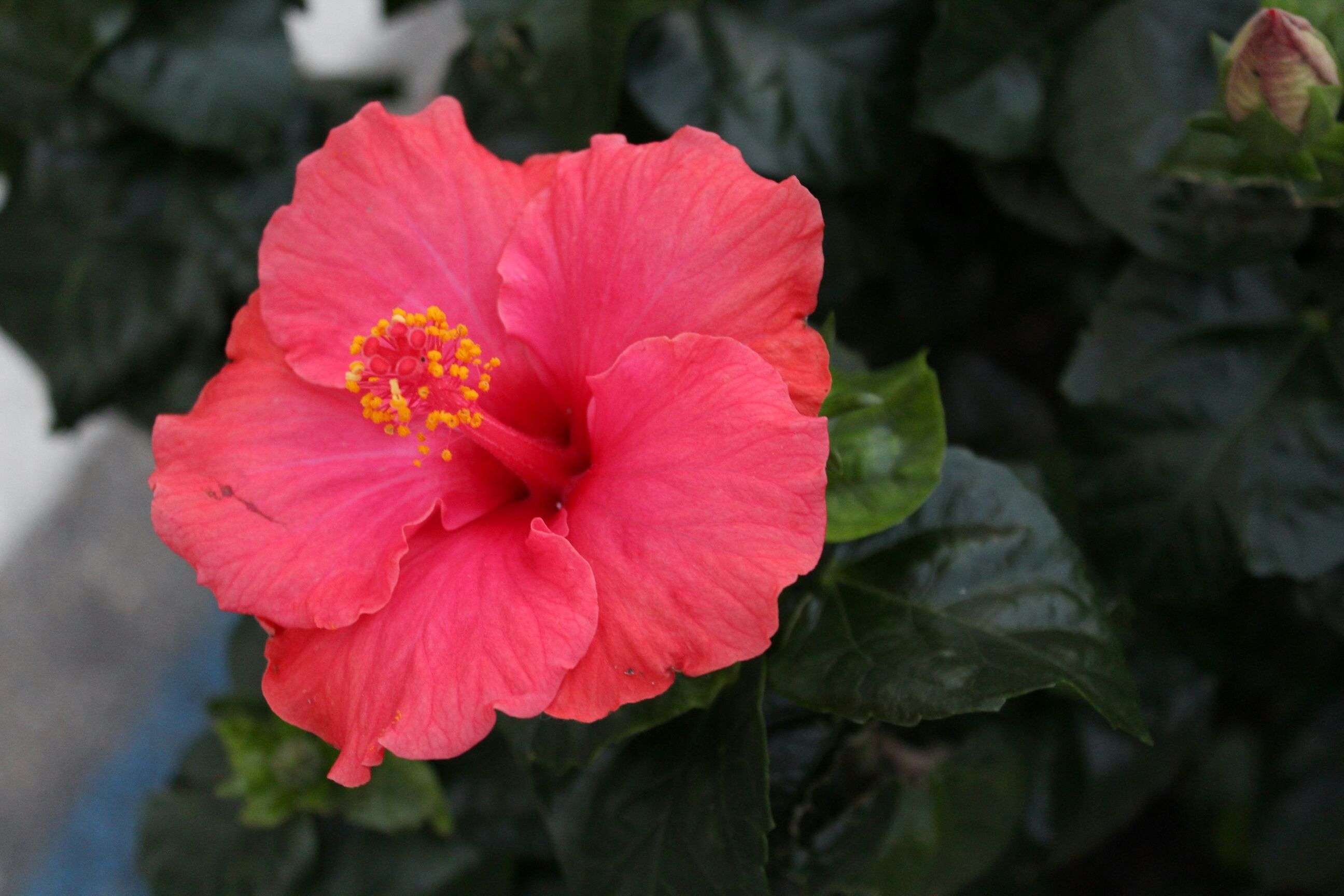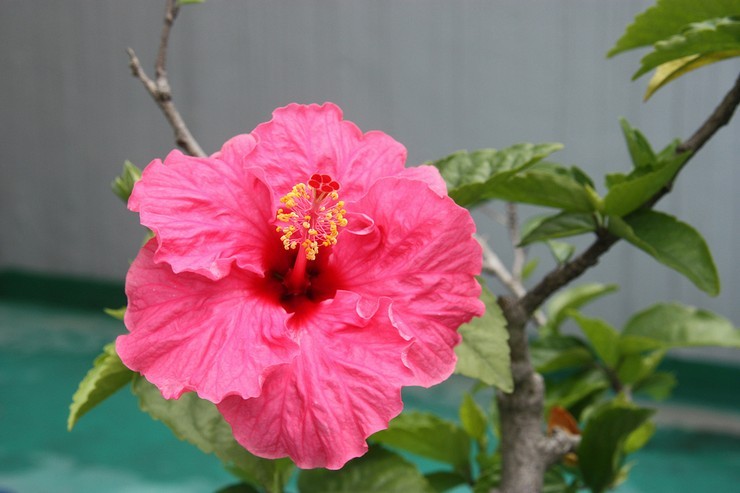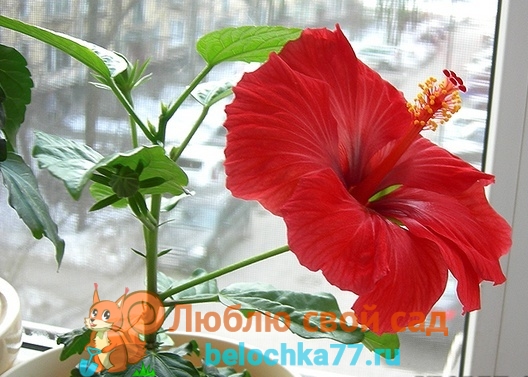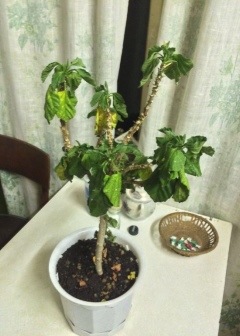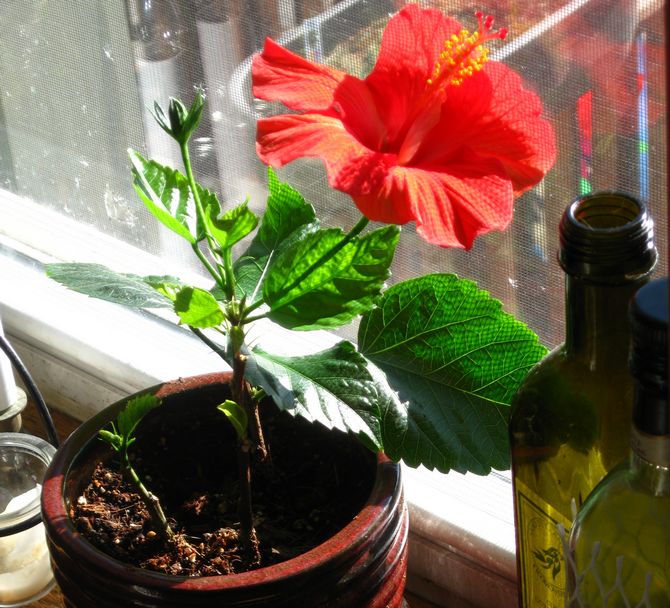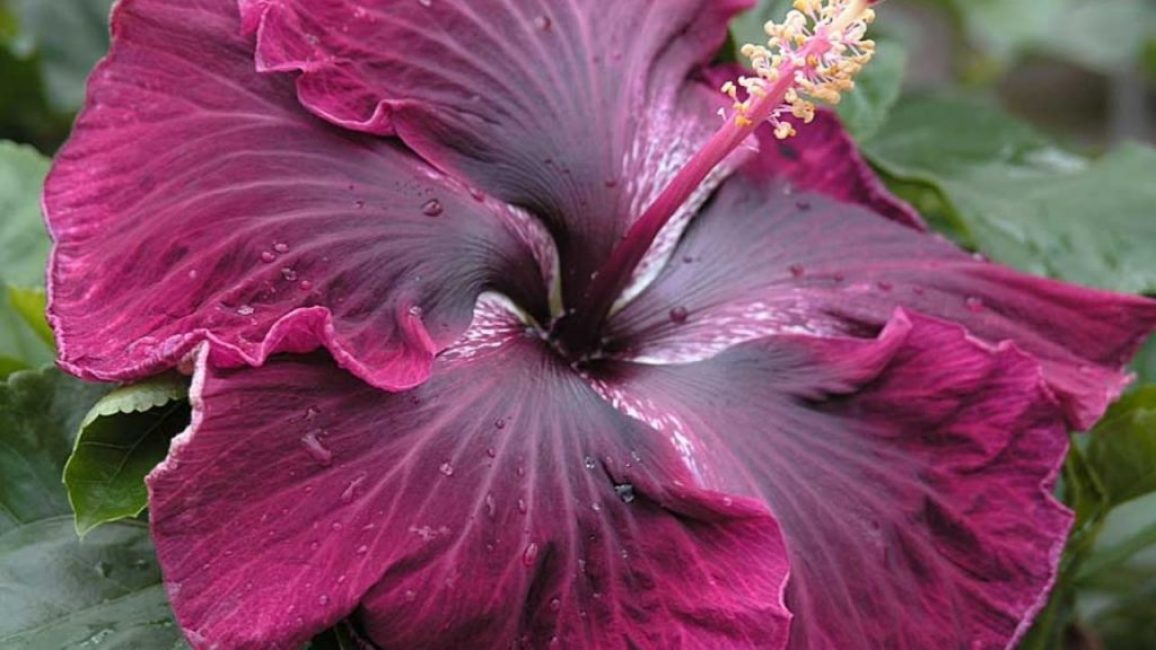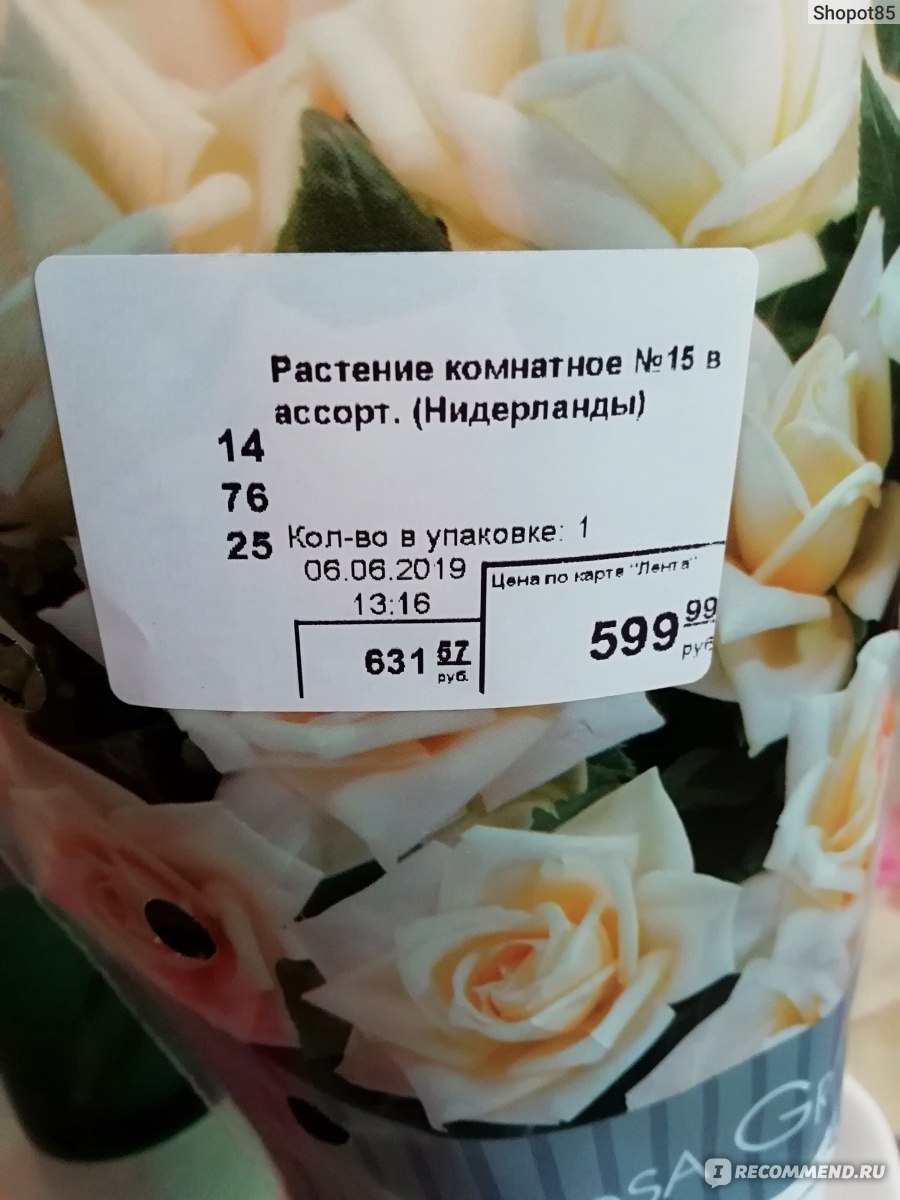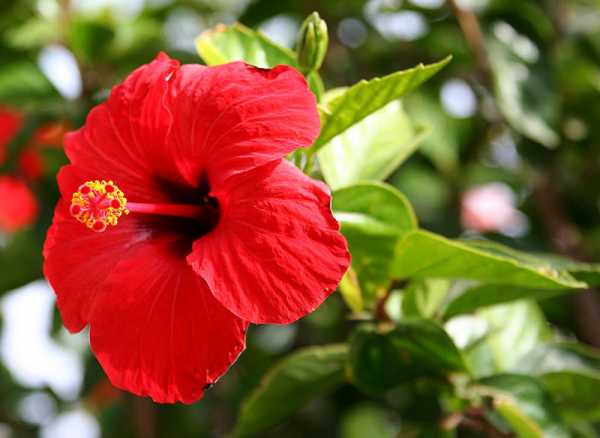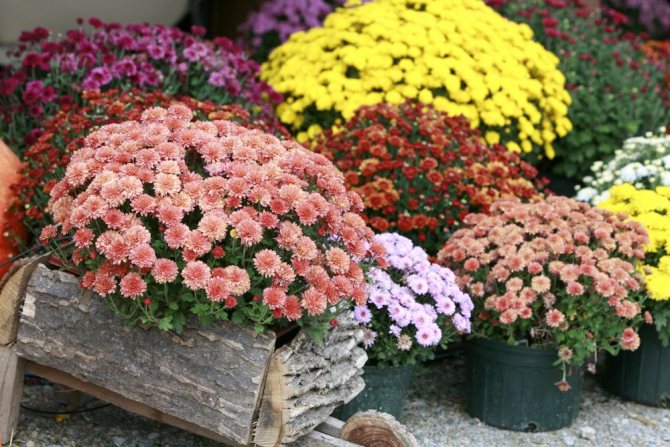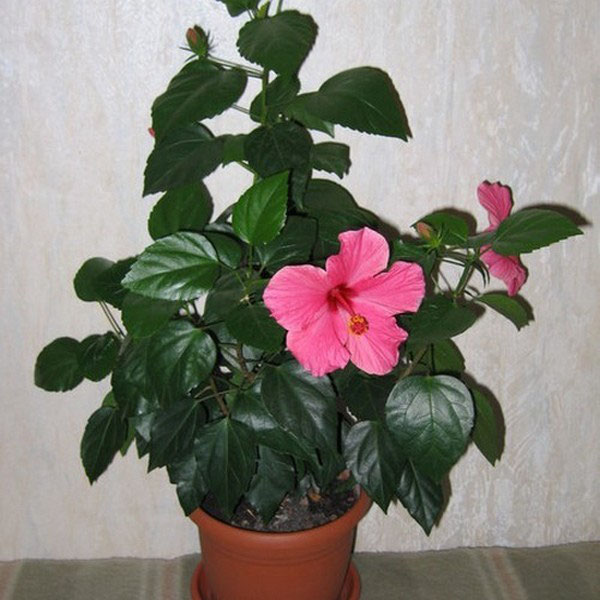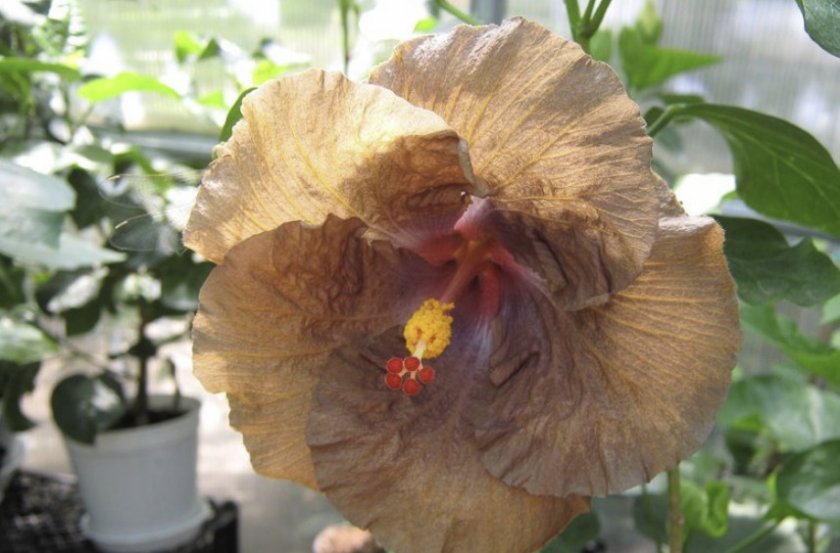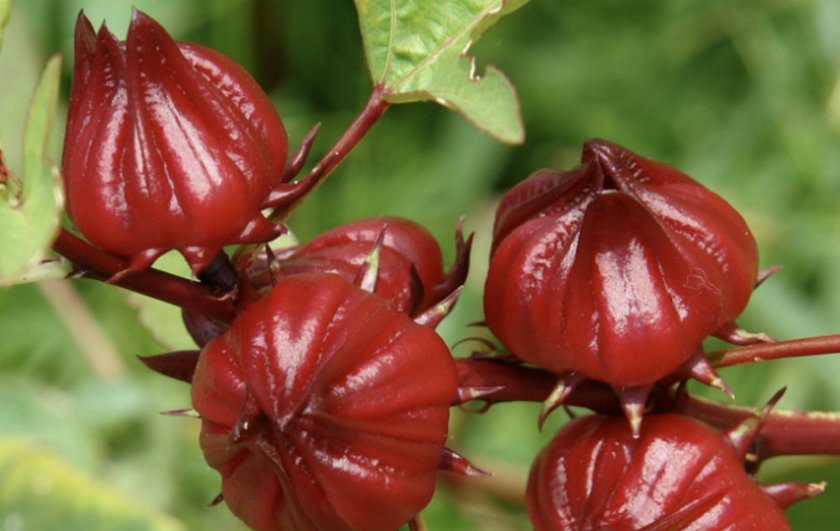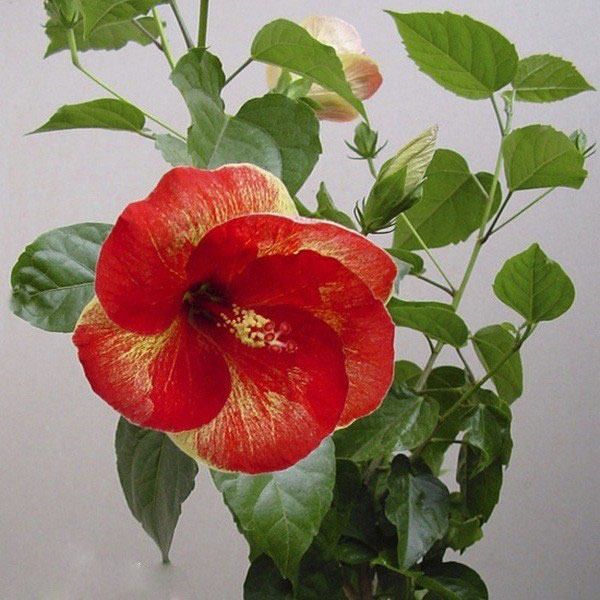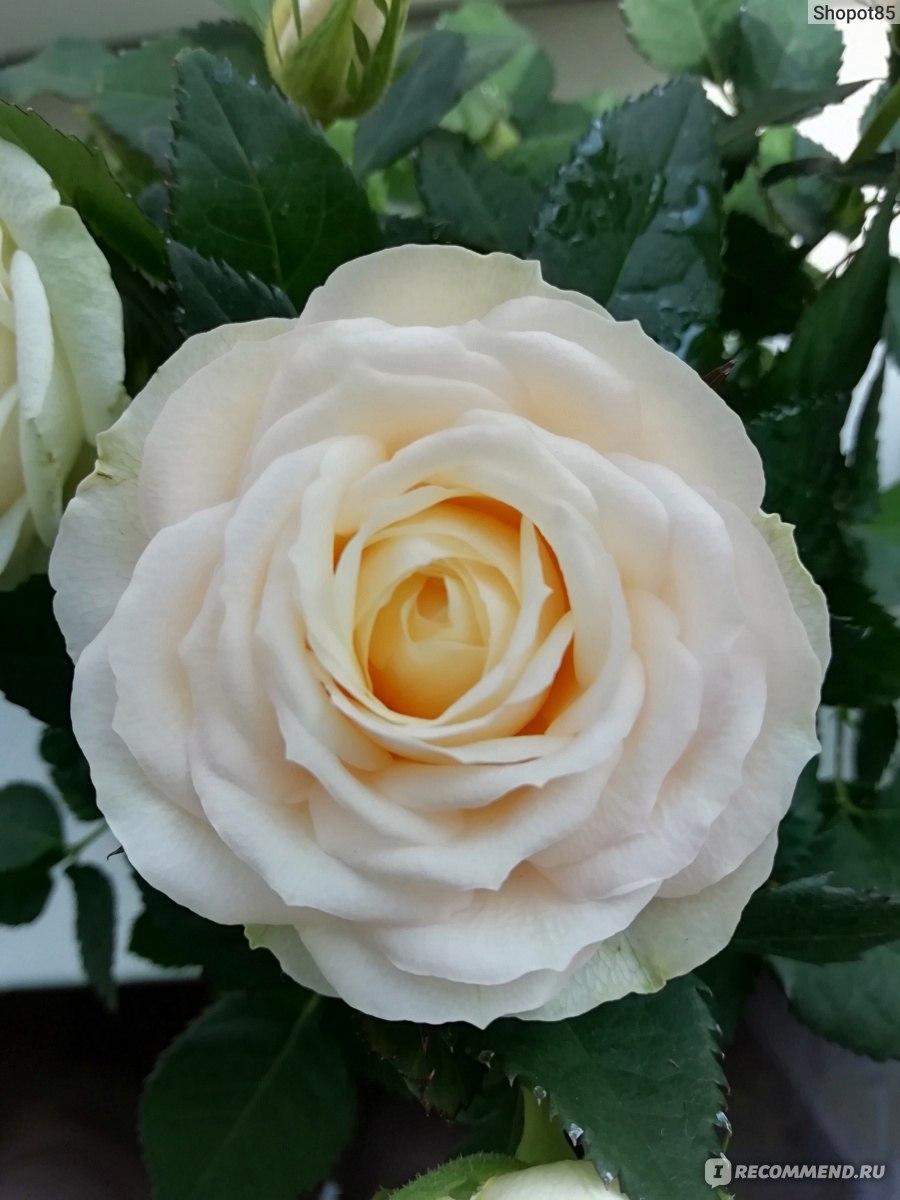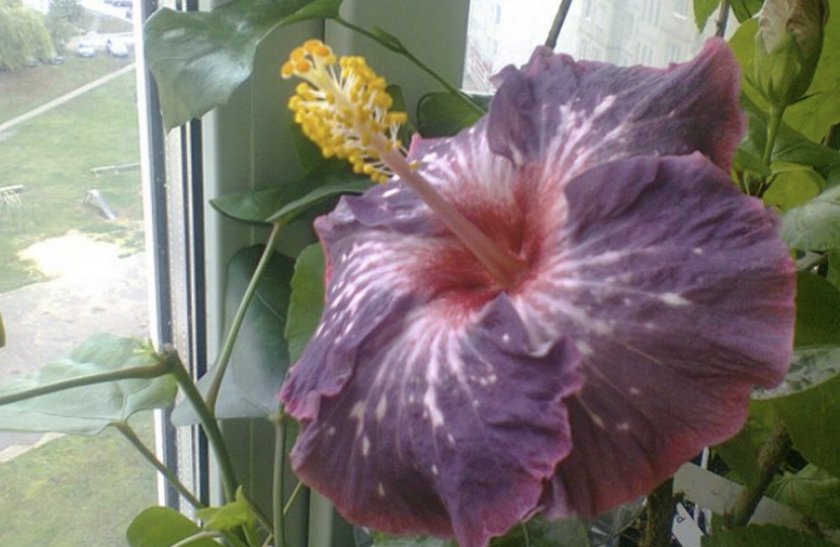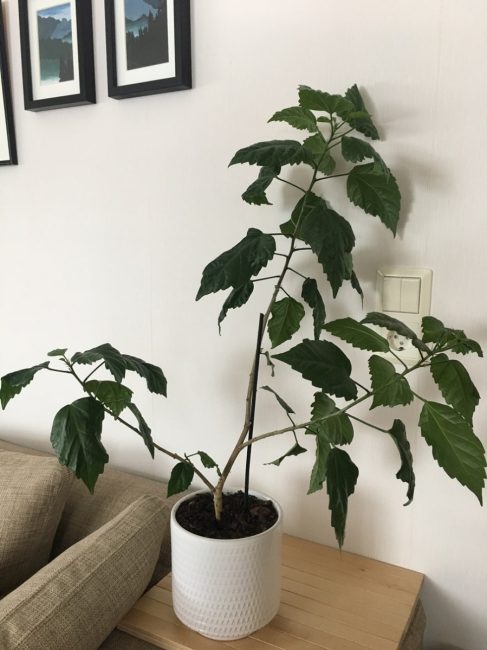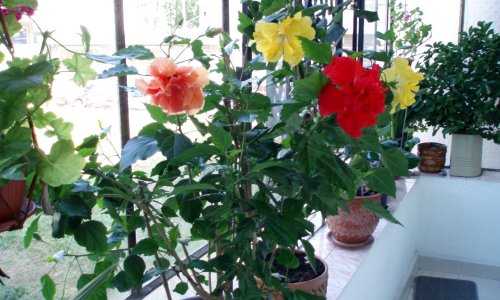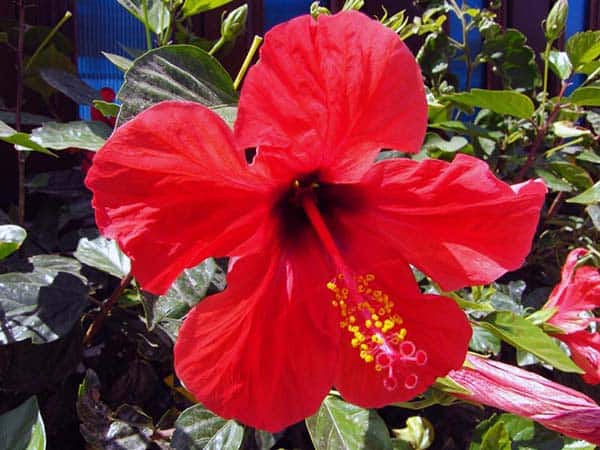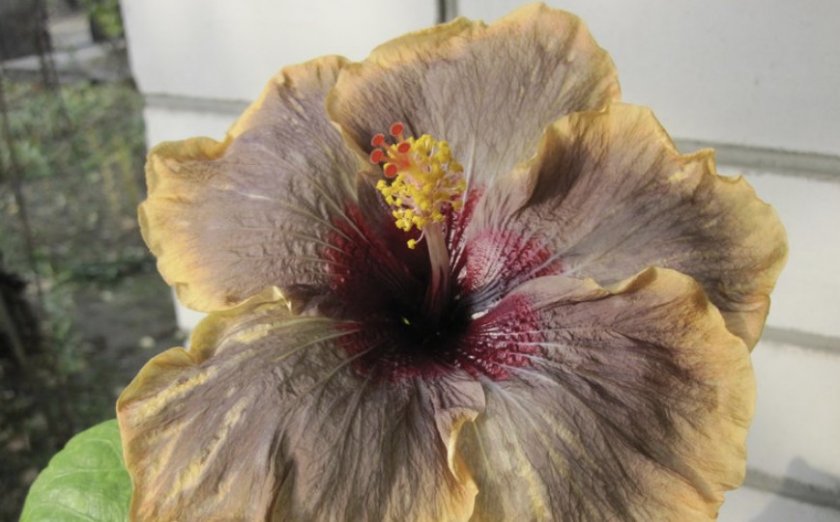Hibiscus care
Garden hibiscus grown in open soil is not difficult to care for. After young green stems appear on the bush, all dried old shoots are cut off from it. Systematically loosen the soil around the tree, pull up weeds in a timely manner, and also prevent the bush from thickening.
Fertilizer
During the growing season (June – September), the plant is regularly fed once every 2 weeks, for this, a fertilizer with an increased content of phosphorus and nitrogen is used. And in the autumn, during the preparation of the bush for wintering, in addition to phosphorus fertilizers, it is also fed with potash fertilizers.
After the flower blooms, it will live for only 24 hours, and then it will wither. However, if the bush is well cared for, it will bloom very luxuriantly, and immediately after one flower withers, another will bloom. In order for the bush to always be neat, it is necessary to regularly pick off the flowers that have begun to fade.
Watering
In order for the flower to grow and develop normally, it must be watered in a timely manner, special attention is paid to this in hot weather. However, watering is carried out only when the soil surface near the bush is completely dry.
In the event that there is a prolonged dry period, watering the hibiscus is carried out every day.
Pruning hibiscus
The culture needs sanitary, as well as formative pruning, with which you can give the desired shape to the bush. Most often it is shaped like a tree, but this will take a lot of time and patience. In a newly planted young bush, the branches are shortened to 2 or 3 buds, while a well-developed trunk does not need to be touched. In subsequent years, in the last winter weeks, trim the lateral shoots to 1–2 buds, and the stem to 5–6 buds. After the height of the stem suits you, start forming the crown of the plant, for this, the strong shoots are shortened by several buds. Cut out all the undergrowth and trim off the top of the stem.
In the first spring weeks, before the sap flow begins, sanitary pruning of hibiscus is carried out. To do this, cut out all affected by the disease, old, growing inside the bush and weak shoots, then shorten last year's growth by 1/3 part, this helps to stimulate the laying of new flower buds. The main rule in pruning hibiscus, the more the bush is trimmed, the more young shoots it will grow, and this will lead to more lush flowering.
If you need to rejuvenate the plant, then for this, all the dried old branches are cut off from it, and the remaining stems inside the bush are shortened by 2/3. In order to make the shape of the bush more attractive, it is recommended to cut the branches around the main stem to different heights.
Hibiscus transplant
Sometimes it happens that an adult hibiscus bush has to be transplanted to a new place. This is done in early spring after all the shoots have been shortened by ½ part and always before the bush blooms. The transplant is carried out in the same way as the landing (see above).
After the plant is transplanted, it is well watered. In the future, he is looked after in the same way as other adult hibiscus. A year later, flowers will appear on the bush. When transplanting a hybrid hibiscus, you can divide the rhizome if desired.
Syrian Hibiscus - My Care Secrets
Optimal conditions of detention
Indoor varieties of the Chinese rose can be grown even by a novice grower, it is enough just to find a comfortable place for hibiscus and provide the necessary conditions for growth. Caring for a room Chinese rose does not take much time, and the result will delight everyone around.
Air temperature and humidity
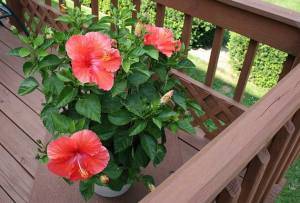 The optimum temperature for growing roses in the summer is 20-25 degrees.
The optimum temperature for growing roses in the summer is 20-25 degrees.
In winter, for a positive effect on future flowering, it is recommended to keep hibiscus in conditions of + 14-16 degrees, however, a decrease in temperature values below +12 is undesirable.
The Chinese rose does not react well to dry indoor air.
Due to insufficient moisture, its buds fall off without opening. The situation will be corrected by frequent spraying, which should not affect the rose flowers. In summer, it is advisable to expose the pot with the plant to fresh air, but at the same time it must be protected from direct sun, wind and rain.
Lighting
When choosing a place for a Chinese rose, you need to remember that it is a lover of bright indirect light, so it will feel best next to a window. However, care should be taken to ensure that the plant is not in a draft. Lack of lighting can result in no flowering or shedding of unopened buds.
Watering and feeding
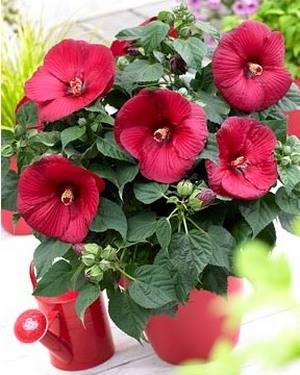 The Chinese rose is a big lover of moisture, therefore, in warm weather, it needs generous watering and spraying, for which they use soft, settled water at room temperature.
The Chinese rose is a big lover of moisture, therefore, in warm weather, it needs generous watering and spraying, for which they use soft, settled water at room temperature.
In winter, watering is reduced, and they are produced as the topsoil dries out, preventing flooding or excessive drying of the substrate.
During the growing season, and this is from spring to mid-autumn, hibiscus, due to its active growth, needs weekly feeding.
It is recommended to alternate the use of organic and mineral fertilizers. By the end of summer, fertilizing with nitrogen fertilizers is reduced, and in winter, the introduction of fertilizers is stopped altogether.
Transplant and soil
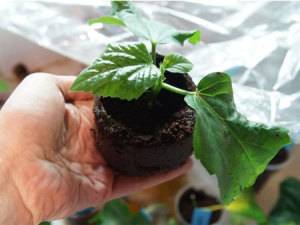 A young plant needs to be transplanted into a new, slightly larger pot every season. Adult plants can get by with a partial replacement of the top layer of soil in a pot, and their transplant (transfer) is done no more often than once every 3-4 years.
A young plant needs to be transplanted into a new, slightly larger pot every season. Adult plants can get by with a partial replacement of the top layer of soil in a pot, and their transplant (transfer) is done no more often than once every 3-4 years.
Hibiscus needs nutritious soil, consisting of leafy, clay-sod and humus soil, taken in a ratio of 1: 2: 1. It is advisable to add bone meal and sand to this mixture.
When choosing a pot, it should be borne in mind that too spacious a container will lead to abundant growth of hibiscus foliage, and the plant will not bloom. Before transplanting a Chinese rose, ensure good drainage, since stagnant water has a bad effect on the condition of the plant's roots.
How to transplant hibiscus correctly will be shown to you by professionals in the video:
Cuttings
The greatest aesthetic pleasure is delivered by flowers that are grown independently, and their beauty will not be conveyed by a photo of a hibiscus (Chinese rose). But before you can admire them, flowers need to be grown. To do this, in the spring or summer, you need to stock up on cuttings. You can get them by pruning the plant before transplanting. The main thing is that the hibiscus is well watered before the procedure.
The resulting cuttings can be rooted in 2 ways:
- In water.
- In the ground.
In order to plant a new plant, you need to wait until good roots appear that can hold an adult plant. The rooting process is as follows. You need to take the glasses and fill them one third with soil. Before planting, the cutting is moistened in heteroauxin. Around the cutting, the soil is compacted and watered with water at room temperature. The soil should contain peat and be slightly loose. It can take about a month before planting. The cups are stored in the greenhouse or covered with a bag.
To root a hibiscus (Chinese rose) in water, home care must be appropriate. To do this, you need to follow a number of rules:
- The container in which the handle is placed should be glass, dark in color.
- Water must be used warm and settled.
- A couple of activated charcoal tablets can be added to a glass of water.
- Also, 3-4 drops of fertilizer are added to the water.
- It is better to place a glass of water in a place with good lighting, but so that direct sunlight does not fall on it.
- Water needs to be topped up regularly and root growth should be monitored.
When the roots reach a length of seven centimeters and a couple of leaves appear, the plant can be planted in a flower pot.
Tips for growing a Chinese rose
Hibiscus development, flowering and beauty depend on whether or not the care of the hibiscus is carried out correctly. It is recommended for indoor hibiscus home care for the following factors:
- Location, lighting. Hibiscus needs space and light. Therefore, it is recommended to put it in a bright place, for example, a windowsill. It grows very quickly, therefore, you need to take this into account so that later there will be no problems, because a small room for hibiscus is not suitable (there will simply be nowhere to put it). The pot for it needs "to grow", it will not grow in a small compact pot.
- Temperature conditions. For hibiscus, the temperature is suitable: in the summer months it is about 21 degrees, and in the winter - 15 degrees (the reduced temperature in the winter months is good for the future, when the hibiscus blooms). It is not worth worrying if there is no opportunity to comply with such a regime.
- Humidity. Hibiscus loves moisture, but don't overdo it. You need to spray it often, but make sure that the water does not touch the buds. Otherwise, the flowers, not having time to open, become dotted and fall off. And, if you keep a Chinese rose in a room with a lack of humidity, then this will lead to the fact that, although the flowers will not fall off, they will not be able to open up in all their glory. It is recommended to place a tray under the pot, but so that the bottom of the pot does not touch it. And put pebbles or expanded clay into the tray itself and fill with water. This method is effective for increasing air humidity.
- Watering. Since the Chinese rose loves moisture, then watering this plant should be taken very carefully. Watering the plant, you should observe that the soil is completely saturated with water, and arrange the next watering in 2-3 days or when the top layer of the earth dries up. It is advisable to use rainwater or melted snow, not cold. Tap water is not suitable for watering plants, as it contains a large amount of bleach.
- The soil. Hibiscus loves neutral, light and nutritious soil (pH around 6). An excellent option would be a mixture of soils in a ratio of 4: 3: 1: 1 - turf, leaf, humus, sand with the addition of a small amount of charcoal. A simpler version of a mixture of turf, humus and sand in a ratio of 2: 1: 1 is possible. It is also necessary to ensure that there is no stagnation of water in the pot, for this drainage is needed.
- Fertilizers, top dressing. It is impossible to cover the Chinese rose generously with fertilizers. It is necessary to feed the hibiscus with potassium-phosphorus fertilizer in the spring, when the plant is about to start growing and in the summer, when growth is in full force, then any fertilizers can be used, except those that contain nitrogen.
- Transplants. Until the hibiscus is three years old, it needs to be transplanted once a year into prepared soil - the mixture should consist of soil from the garden, sand and peat in a ratio of 2: 1: 1. After three years of hibiscus, it is recommended to replant it once every couple of years and prepare the soil more difficult.
- Pruning. In order for the plant to bloom its flowers annually, it is definitely necessary to cut it after the flowering of the indoor hibiscus flower. Formative pruning consists in the fact that after the shoots have already faded, they need to be cut to give strength to the growth and flowering of new lateral shoots.Each uncut wilted flower is in the future a simple branch with leaves, because hibiscus flowers appear only on young shoots.
Hibiscus soil
The root system of a large plant requires a constant supply of oxygen. Heavy soil will make it difficult for the tree to aerate and absorb nutrients.
For good growth and future flowering, it is better to mix the soil yourself. To do this, you need to cook one part at a time:
sand;
peat;
turf land;
ordinary garden soil;
rotted leaves.
Charcoal can be added. To feed the hibiscus, you need to mix wood ash into the soil - for 10 kg of soil, 2 glasses of ash. Ash also contributes to loosening and inflow of soil and at first there will be something to feed the indoor hibiscus so that it blooms after rooting.

Drainage is placed at the bottom of a spacious pot - stones, pebbles, shells, expanded clay. Chinese rose not tolerates stagnant water in a pot. You may need to change the irrigation method and add water to the sump to dry the soil.
Types and varieties of Syrian hibiscus with a photo
As mentioned above, Syrian hibiscus, as well as its varieties, are most often cultivated in the garden. But other types of such plants and their various varieties are grown in the open field.
Syrian hibiscus (Hibiscus syriacus)
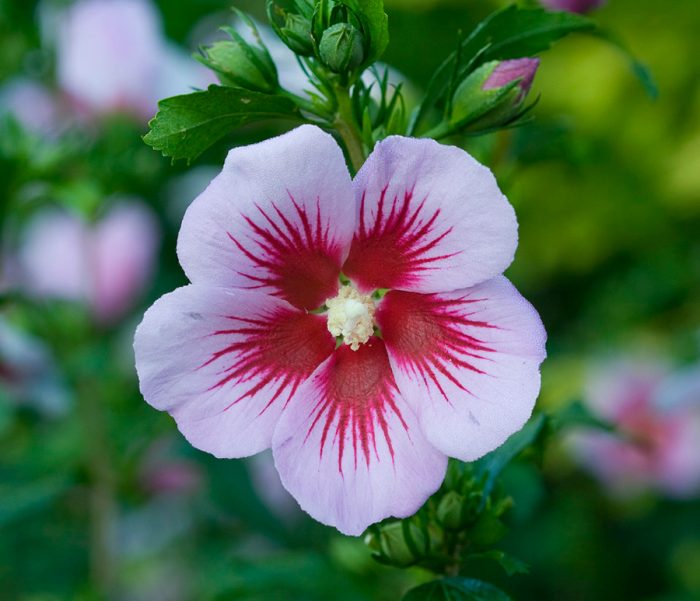
The homeland of such a plant is not Syria, but China. Under natural conditions, this species is a deciduous shrub, which can reach a height of 5-6 meters. The shape of the rich green leaf plates is ovoid, and their length is up to 10 centimeters. During flowering, single flowers bloom, which can be painted in different colors. Gardeners cultivate hibiscus with both simple and double flowers, while the shape of the plant is both standard and bush. The best varieties:

- Diana. The height of the shrub is about 200 cm. White flowers reach 12 centimeters in diameter, the edge of their petals is wavy.
- Vayelith Ilar Double. This upright powerful shrub is decorated with semi-double or double flowers of a bluish-purple color with red spots in the middle.
- Pink Giant. Single pink flowers have a purple spot at the base.
- Carneus Plenus. The stems of such a shrub are very flexible. Double flowers of a pale pink shade are decorated with a crimson speck located in the middle.
Hibiscus trifoliate (Hibiscus trionum)

The homeland of this species is North and Central Africa. However, today it is widely cultivated in all areas of irrigated agriculture. Hibiscus has a taproot, as well as a branched straight stem, the height of which is about 0.8 m. There is pubescence on the surface of the alternate tripartite leaf plates, and they also have a petiole. The pale yellow flowers reach about 40 mm in diameter, with a dark red center. This species has one characteristic feature: its flowers open in the morning, and close in the afternoon. The flowering period of such a plant is more than 30 days. The fact is that new buds are formed in the axils of each leaf plate, and if the bush grows in favorable conditions, then the formation of flowers will occur every day.
Hybrid hibiscus (Hibiscus hybrida)
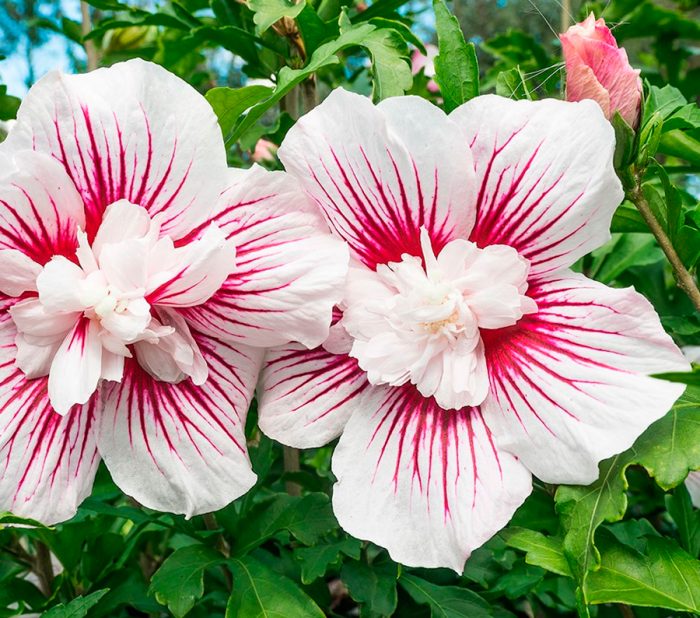
In addition to these species, which can be found in the garden and in natural conditions, gardeners also cultivate hybrid hibiscus, as well as its varieties. It was already mentioned above that breeders obtained this plant by crossing 3 North American species, namely: bright red, armed (holly) and marsh hibiscus. Hybrid hibiscus are herbaceous perennial plants that produce very large and beautiful flowers during flowering. Popular varieties:
- Youth. The height of the weakly branched plant is about 150 cm. The stems are painted in a pale greenish-yellow color, the shoots depart from them at an angle of 60 degrees.Three-cut or five-cut sheet plates are colored greenish-yellow. In pink flowers, the bowl and bottom are white, they reach up to 100 mm in diameter and have the shape of a tulip.
- Late. Such a compact, densely leafy bush reaches a height and diameter of about 100 cm. The shape of leaf plates with a serrated edge is oval-arrow-shaped, their petioles are thick, and the veins are light in color. Pinkish-crimson flowers with a lilac tint have the shape of narrow bells, in diameter they reach 70 mm. Flowers are formed on thick short peduncles.
- Pale pink. The height of the herbaceous bush is about 1.7 m, short shoots extend from the stems at an angle of 60 degrees. The foliage is three-cut, it has a greenish-yellow color. Pink tulip-shaped flowers reach about 12 centimeters in diameter, their bowl and bottom are white.
- Porcelain pink. The height of the bush with greenish-yellow branched stems is about 1.3 m. The middle lobe of deeply incised leaf plates is wide and protruding, they are painted in a dusty greenish-yellow color, and their petioles reach 60 mm in length. On short peduncles, large pinkish bell-shaped flowers with a barely distinguishable yellowish tinge sit in bundles, they reach about 12 centimeters in diameter.
Hibiscus species and varieties
Why indoor Chinese rose does not bloom
Many growers have faced a problem at least once when their hibiscus refuses to bloom, although at first glance it looks completely healthy.
The main reasons why a plant is not a color:
- Lack of light and moisture.
- Lack of nutrients in the soil, especially phosphorus.
- Overfeeding the plant with nitrogen-containing fertilizers.
- Late trimming or lack of trimming.
- The shrub is planted in a container that is too wide.
- The dormant period was not organized for the plant.
- Diseases and pests.
 It is inappropriate care that leads to the fact that the hibiscus refuses to bloom.
It is inappropriate care that leads to the fact that the hibiscus refuses to bloom.
Flowering period and violation of the rules of care
With proper care, hibiscus can bloom for several months. As a rule, the flowering period occurs during the summer season and can last from June to September. The lifespan of one flower is one, maximum two days. Improper care of flowering hibiscus can lead to dropping of still unopened buds or rapid fall of flowers:
- Poor watering, lack of nutrients in the earthen substrate, keeping the bush in a cold room, as well as a draft lead to the fall of buds that have not yet had time to open.
- Hibiscus reacts in the same way to a sharp change in the place of detention, therefore, it is impossible to rearrange the flowering shrub.
- Lack of light during the flowering period will significantly shorten its duration.
- It is also worth remembering that water should not be allowed to enter the flowers of the shrub, otherwise they will become covered with spots and fall off.
Diseases, pests
Some diseases also prevent the plant from blooming:
- Watering the plant with hard water, high in chlorine, causes chlorosis. In the presence of this disease, the old leaf plates of the bush begin to fall off, and the new ones grow yellow. Treatment includes: replanting the plant, changing the water for irrigation to soft water with the addition of iron chelate.
- Excessive watering can lead to decay of the root system, as a result of which the hibiscus begins to bare. Lack of treatment or untimely solution of the problem can lead to the death of the bush.
- A dry indoor climate is an optimal breeding environment for spider mites. You can detect the pest by a thin web on the back of the leaf plates. Treating the bush with soapy water or acaricide will help kill pests.
- Also, hibiscus can be affected by aphids. The insect primarily affects the buds and young leaves of the bush. To cope with the parasite is possible only with the help of systemic insecticides.

